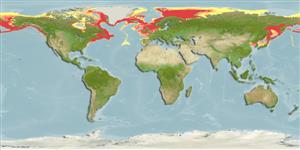Common names from other countries
Environment: milieu / climate zone / depth range / distribution range
Ecologie
Benthopelagisch; diepteverspreiding 9 - 1450 m (Ref. 85480), usually 50 - 500 m (Ref. 85480). Boreal; -2°C - 12°C (Ref. 85480), preferred 4°C (Ref. 107945); 82°N - 35°N, 180°E - 180°E (Ref. 85480)
Circumpolar. Temperate to polar.
Length at first maturity / Size / Gewicht / Leeftijd
Maturity: Lm 2.4, range 2 - 2.443 cm Max length : 12.0 cm TL mannelijk/geslacht niet bekend; (Ref. 8); 16.5 cm TL (female)
Commonly known as the "pink" shrimp, it is slender and has a smooth body surface. The shell is somewhat thin, making it more difficult to transport in good condition than the other species. Moreover, although a deep red when alive, it becornes pink after boiling, a quality which also detracts from the commercial value of the unshelled product. The rostrum is about one and three fourths times as long as the carapace, slightly arched above the eyes, terminal half slightly ascending, armed with 12 to 16 teeth above (including 3 or 4 on the carapace), 6 to g teeth below, tip bifid. The anterior dorsal spine is situated at least as far forward as the distal third of the rostrum.
Considered as free-living (Ref. 3123) stenohaline species living on soft substrates with high organic content. It is an opportunistic omnivore functioning as a predator and a scavenger (Ref. 85480).
Post-larvae mature first as males for 2 years, sex transition begins afterwards. Spawning begins on the third winter, hatching occurs during spring (Ref. 82652). Reproductive mode from Ref. 91801.
Piepenburg, D., N.V. Chernova, C.F. von Dorrien, J. Gutt, A.V. Neyelov, E. Rachor, L. Saldanha and M.K. Schmid. 1996. (Ref. 2952)
Status op de Rode Lijst van het IUCN (Ref. 130435)
Status bij CITES (Ref. 108899)
Not Evaluated
Not Evaluated
Gebruik door de mens
Visserij: commercieel
FAO - Visserij: landings, soortsprofiel | FIRMS (Stock assessments) | FishSource | Sea Around Us
Tools
Internet-bronnen
Estimates based on models
Preferred temperature
(Ref.
115969): -0.9 - 5.6, mean 1.9 (based on 2142 cells).
Weerstandsvermogen
Gemiddeld, minimale populatieverdubbelingstijd 1,4-4,4 jaar (K=0.16-0.29; tm=5.71).
Prior r = 0.62, 95% CL = 0.41 - 0.93, Based on 7 full stock assessments.
